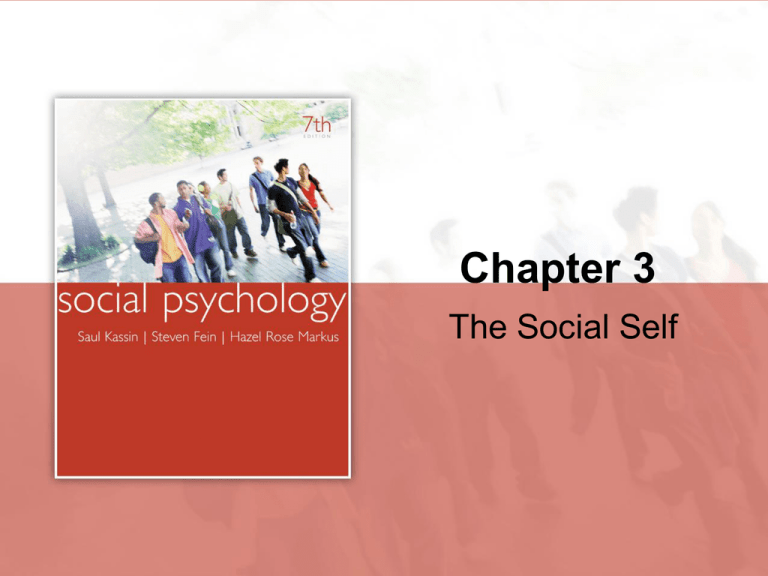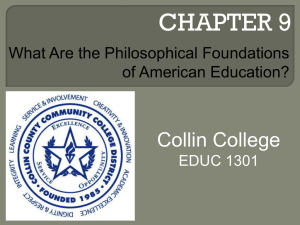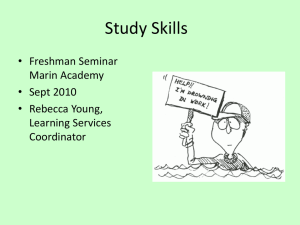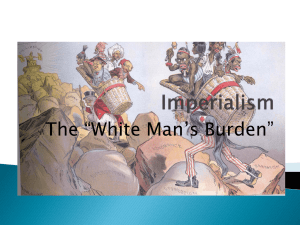
Chapter 3
The Social Self
The Role of the “Self”
• Capacity for self-reflection is necessary for selfunderstanding
– Private, “inner” self
• Self is heavily influenced by social factors.
– Public, “outer” self
Copyright © Houghton Mifflin Company. All rights reserved.
3|2
The ABCs of the Self
• Affect: How do we evaluate ourselves, enhance
our self-images, and defend against threats to
our self-esteem?
• Behavior: How do we regulate our actions and
present ourselves according to interpersonal
demands?
• Cognition: How do we come to know ourselves,
develop a self-concept, and maintain a stable
sense of identity?
Copyright © Houghton Mifflin Company. All rights reserved.
3|3
Putting Common Sense to the Test…
Humans are the only animals who recognize
themselves in the mirror.
Answer: False… Let’s see why!
Copyright © Houghton Mifflin Company. All rights reserved.
3|4
The Self-Concept
• Self is an important object of our attention.
– Cocktail party effect.
• Self-Concept: The sum total of beliefs that
people have about themselves.
• Self-concept is made up of self-schemas.
– Self-Schema: Beliefs about oneself that guide
processing of self-relevant information.
Copyright © Houghton Mifflin Company. All rights reserved.
3|5
Rudiments of the Self-Concept
• Except for human beings, only the great apes
seem capable of self-recognition.
• Self-recognition is an important first step in the
development of a self-concept.
• Social factors influence development of a selfconcept.
– “Looking-glass self”
– Self as relational
Copyright © Houghton Mifflin Company. All rights reserved.
3|6
Where Does Our
Self Concept Come From?
Copyright © Houghton Mifflin Company. All rights reserved.
3|7
Source #1: Introspection
• Self-knowledge through looking inward at one’s
own thoughts and feelings.
• But does introspection always lead to accurate
self-knowledge?
– Wilson (2002): Introspection can sometimes impair
self-knowledge!
Copyright © Houghton Mifflin Company. All rights reserved.
3|8
Other Problems With Introspection
• We have difficulty in predicting responses to
future emotional events.
– Affective Forecasting
• We tend to overestimate the strength and
duration of our emotional reactions.
– “Durability bias”
Copyright © Houghton Mifflin Company. All rights reserved.
3|9
Why a Durability Bias?
• For negative events, we do not fully appreciate
our psychological coping mechanisms.
• We focus only on the emotional impact of a
single event, overlooking the effects of other life
experiences.
Copyright © Houghton Mifflin Company. All rights reserved.
3 | 10
Putting Common Sense to the Test…
Smiling can make you happier.
Answer: True… Let’s see why!
Copyright © Houghton Mifflin Company. All rights reserved.
3 | 11
Source #2: Perceptions
of Our Own Behavior
• Daryl Bem (1972): People can learn about
themselves simply by watching their own
behavior.
• Self-Perception Theory: When internal cues are
difficult to interpret, people gain insight by
observing their own behavior.
– But only in the absence of compelling situational
pressures.
Copyright © Houghton Mifflin Company. All rights reserved.
3 | 12
Self-Perceptions of Emotion
• Facial Feedback Hypothesis: Changes in facial
expression can lead to changes in the subjective
experience of emotions.
• Laird (1974): Facial expressions affect emotion
through process of self-perception.
– Alternative explanation: Facial movements evoke
physiological changes that produce an emotional
experience.
Copyright © Houghton Mifflin Company. All rights reserved.
3 | 13
Self-Perceptions of Motivation
• Intrinsic versus Extrinsic Motivation.
– Intrinsic Motivation: Originates in factors within a
person
– Extrinsic Motivation: Originates in factors outside the
person
• What happens to intrinsic motivation once a
reward is no longer available?
– Overjustification effect
Copyright © Houghton Mifflin Company. All rights reserved.
3 | 14
Figure 3.1: Paradoxical Effects
of Reward on Intrinsic Motivation
From M.R. Lepper, D. Greene, and K.E. Nisbett, "Undermining Children's Intrinisic Interest with Extrinsic Reward: A Test of the
'Overjustification' Hypothesis," Journal of Personality and Social Psychology, Vol. 28, 1973, pp. 129-137. Reprinted with permission.
Copyright © Houghton Mifflin Company. All rights reserved.
3 | 15
Understanding the Paradox
• Should rewards NOT be offered?
• What is important is how the reward is perceived
and by whom.
• People differ in their motivational orientations
toward work.
Copyright © Houghton Mifflin Company. All rights reserved.
3 | 16
Source #3: Influences of Other People
• People tend to describe themselves in ways
that set them apart from others in their
immediate vicinity.
• The self is “relative.”
– We define ourselves in part by using others as a
benchmark.
Copyright © Houghton Mifflin Company. All rights reserved.
3 | 17
Social Comparison Theory
• Festinger (1954): When uncertain about our
abilities or opinions, we evaluate self through
comparisons with similar others.
• Key Questions:
– When do we turn to others for comparative
information?
– With whom do we choose to compare ourselves?
Copyright © Houghton Mifflin Company. All rights reserved.
3 | 18
Two-Factor Theory of Emotion
• Can others help determine our emotions?
– Schachter: Misery loves only miserable company.
• Two factors necessary to feel a specific emotion:
– We must experience physiological arousal.
– We must make a cognitive interpretation that
explains the source of the arousal.
Copyright © Houghton Mifflin Company. All rights reserved.
3 | 19
Two-Factor Theory (cont.)
• For others to influence our emotions:
– Our level of physiological arousal cannot be
too intense.
– Other people must be present as a possible
explanation for arousal before its onset.
Copyright © Houghton Mifflin Company. All rights reserved.
3 | 20
Source #4:
Autobiographical Memories
• Essential for a coherent self-concept.
• Typically report more events from the recent
than the distant past.
• Exceptions to this recency rule:
– Reminiscence peak
– Tendency to remember transitional “firsts”
Copyright © Houghton Mifflin Company. All rights reserved.
3 | 21
Source #4:
Autobiographical Memories (cont.)
• Flashbulb memories serve as prominent
landmarks in our autobiographies.
• Autobiographical memory is a vital part of, and
can be shaped by, our identity.
– Often motivated to distort the past in ways that are
self-inflated.
Copyright © Houghton Mifflin Company. All rights reserved.
3 | 22
Figure 3.2: Distortions in
Memory of High School Grades
From Bahrick et al., 1996, Psychological Science, 1996 Vol. 7, pp. 266-271.
Copyright 1996 Blackwell Publishing. Reprinted with permission.
Copyright © Houghton Mifflin Company. All rights reserved.
PSYCHOLOGICAL SCIENCE, V7 (1996), p. 266. Copyright by the American Psychological Society. Reprinted by permission from Balckwell Publishers.
3 | 23
Source #5: Cultural
Influences on the Self-Concept
• Self-concept is also influenced by cultural
factors.
• Contrasting cultural orientations:
– Individualism: One’s culture values the virtues of
independence, autonomy, and self-reliance.
– Collectivism: One’s culture values the virtues of
interdependence, cooperation, and social harmony.
Copyright © Houghton Mifflin Company. All rights reserved.
3 | 24
Figure 3.3: Cultural
Conceptions of Self
From H.R. Markus and S. Kitayama (1991) "Culture and the Self: Implications for Cognition, Emotion, and Motivation,
" Psychological Review, 98, 224-253. Copyright (c) 1991 by the American Psychological Association. Adapted with permission.
Copyright © Houghton Mifflin Company. All rights reserved.
3 | 25
Influence of Cultural
Orientation on Self
• Individualistic cultures: People strive for
personal achievement.
• Collectivistic cultures: People derive more
satisfaction from the status of the valued group.
Copyright © Houghton Mifflin Company. All rights reserved.
3 | 26
Figure 3.4: What's Your Preferences:
Similarity
or Uniqueness?
Figure
3.4: Which
Subfigures Do
You Prefer?
From H. Kim and H.R. Marcus, “Deviance or Uniqueness, Harmony or Conformity? A Cultural Analysis,
” Journal©ofHoughton
Personality
and Social
Psychology,
Vol.reserved.
77, 1999, pp. 785-800 Reprinted with permission
Copyright
Mifflin
Company.
All rights
H. Kim and H.R. M arcus "Deviance or Uniqueness, Harmony or Conformity? A Cultural Analysis" (1999) from JOURNAL OF PERSONALITY AND
SOCIAL PSYCHOLOGY, 77, 785-800. Copyright (c) 1999 by the American Psychological Association. Reprinted with permission.
Copyright © Houghton Mifflin Company. All rights reserved.
27
3 | 27
Which Colored Pen Would You Like?
80
70
60
Percentage
50
Choosing
40
Unique Colored
30
Pen
20
10
0
American
Copyright © Houghton Mifflin Company. All rights reserved.
East Asian Heritage
3 | 28
Self-Esteem
The Affective Component of the Self
Copyright © Houghton Mifflin Company. All rights reserved.
3 | 29
Why Do We Have
a Need for Self-Esteem?
• Leary & Baumeister (2000): People are
inherently social animals.
– Need for self-esteem is driven by primitive need to
connect with others and gain their approval.
• Greenberg, Solomon, & Pyszczynksi (1997):
Terror Management Theory
Copyright © Houghton Mifflin Company. All rights reserved.
3 | 30
The Need for Self-Esteem
• Satisfying this need is critical to our entire
outlook on life.
• Those with a positive self-image tend to be
happy, healthy, productive, and successful.
• Those with a negative self-image tend to be
more depressed, pessimistic about the future,
and prone to failure.
Copyright © Houghton Mifflin Company. All rights reserved.
3 | 31
Are There Gender
and Race Differences?
• Like individuals, social and cultural groups differ
in their self-esteem.
• Gender differences?
– Among adolescents and young adults, males
outscore females on various general measures of
self-esteem.
– But this difference is very small, particularly among
older adults.
Copyright © Houghton Mifflin Company. All rights reserved.
3 | 32
Figure 3.5: Self-Esteem
in U.S. Minorities
From J. M. Twenge and J. Crocker, “Race and Self-Esteem: Meta-Analysis Comparing Whites, Blacks, Hispanics, Asians, and
American Indians,” Psychological Bulletin, Vol. 128, 2002, pp. 371-408. Reprinted with permission
Copyright © Houghton Mifflin Company. All rights reserved.
3 | 33
Self-Discrepancy Theory
• Self-esteem is defined by the match — or
mismatch — between how we see ourselves
and how we want to see ourselves.
• One’s self-esteem and emotional well-being can
be predicted by examining the discrepancy
between one’s “actual self” and one’s “selfguides.”
Copyright © Houghton Mifflin Company. All rights reserved.
3 | 34
Self-Discrepancy Theory (cont.)
• Self-esteem depends on a number of factors:
– Amount of discrepancy between actual self and selfguide.
– The importance of the discrepancy to the self.
– The extent to which one focuses on one’s selfdiscrepancies.
• What makes us more or less focused on our
personal shortcomings?
Copyright © Houghton Mifflin Company. All rights reserved.
3 | 35
Self-Awareness Theory
• We are not usually self-focused; however,
certain situations may cause us to become
objects of our own attention.
• When we become more self-aware, we naturally
begin to compare behavior with some standard.
This comparison often results in a negative
discrepancy and a temporary reduction in selfesteem.
Copyright © Houghton Mifflin Company. All rights reserved.
3 | 36
Figure 3.6: The Causes
and Effects of Self-Awareness
Copyright © Houghton Mifflin Company. All rights reserved.
3 | 37
Beaman et al.’s Halloween Study
40
35
30
Percentage
25
who violated
20
one piece of
candy request 15
10
5
0
No Mirror
Copyright © Houghton Mifflin Company. All rights reserved.
Mirror Present
3 | 38
Self-Focusing Persons
• Certain individuals are characteristically more
self-focused than others.
• Private vs. public self-consciousness
– Private self-consciousness: Tendency to introspect
about inner thoughts and feelings
– Public self-consciousness: Tendency to focus on
outer public image
Copyright © Houghton Mifflin Company. All rights reserved.
3 | 39
Table 3.1: How Self-Conscious Are You?
Copyright © 1975 by the American Psychological Association. Reproduced with permission. From A. Fenigstein, M.F. Scheier, and A.H. Buss,
"Public and Private Self-Consciousness: Assessment and Theory," Journal of Consulting and Clinical Psychology, 43, 522-527, 1975. No further
reproduction or distribution is permitted without written permission from the American Psychological Association.
Copyright © Houghton Mifflin Company. All rights reserved.
3 | 40
Draw a Capital E on Your Forehead
Percentage
Oriented "E"
for Outside
Observer
45
40
35
30
25
20
15
10
5
0
High
Low
Level of Public Self-Consciousness
Copyright © Houghton Mifflin Company. All rights reserved.
3 | 41
Figure 3.7: Revolving Images of Self
Snyder et al., 1983
Copyright © Houghton Mifflin Company. All rights reserved.
3 | 42
Putting Common Sense to the Test…
Sometimes the harder you try to control a
thought, feeling, or behavior, the less likely
you are to succeed.
Answer: True… Let’s see why!
Copyright © Houghton Mifflin Company. All rights reserved.
3 | 43
Self-Regulation
• Self-regulation is the process by which we seek
to control or alter our thoughts, feelings,
behaviors, and urges.
• Is self-control a limited resource that can
temporarily be depleted by usage?
Copyright © Houghton Mifflin Company. All rights reserved.
3 | 44
Figure 3.8: Self-Control
as a Limited Inner Resource
Muraven & Baumeister, 1998..
Copyright © Houghton Mifflin Company. All rights reserved.
3 | 45
Let’s Try Something...
For the next 30 seconds, think about ANYTHING,
but DO NOT think about a white bear.
30 seconds are up! How did you do?
Copyright © Houghton Mifflin Company. All rights reserved.
3 | 46
Ironic Processes
• Wegner (1994): Sometimes the harder we try to
inhibit a thought, feeling, or behavior, the less
likely we are to succeed.
• Observed in a wide range of behaviors
Copyright © Houghton Mifflin Company. All rights reserved.
3 | 47
Figure 3.9: Ironic Effects
of Mental Control
Keep
Steady
Keep
Steady;
Distracted
Prevent
horizontal
movement
Prevent
horizontal
movement;
distracted
Copyright © Houghton Mifflin Company. All rights reserved.
3 | 48
Putting Common Sense to the Test…
People tend to be overly optimistic about their
futures.
Answer: True… Let’s see why!
Copyright © Houghton Mifflin Company. All rights reserved.
3 | 49
Mechanisms of Self-Enhancement
• How does the average person cope with his or
her faults, inadequacies, and uncertain future?
• We often exhibit implicit egotism, a tendency to
hold ourselves in high regard.
• What methods do we use to rationalize or
otherwise enhance our self-esteem?
Copyright © Houghton Mifflin Company. All rights reserved.
3 | 50
Method #1: Self-Serving Cognitions
• People tend to take credit for success and
distance themselves from failure.
• Most people are unrealistically optimistic.
– Bolster rosy outlook by linking personal attributes to
desirable outcomes
Copyright © Houghton Mifflin Company. All rights reserved.
3 | 51
Putting Common Sense to the Test…
People often sabotage their own performance in
order to protect their self-esteem.
Answer: True… Let’s see why!
Copyright © Houghton Mifflin Company. All rights reserved.
3 | 52
Method #2: Self-Handicapping
• Why do we make excuses?
– Way of protecting self from seeing failure as due to a
lack of ability.
• Self-Handicapping: Behaviors designed to
sabotage one’s own performance in order to
provide a subsequent excuse for failure.
Copyright © Houghton Mifflin Company. All rights reserved.
3 | 53
Individual Differences
in Self-Handicapping
• Gender differences in how we self-handicap.
• Some set their goals too high, which sets up
failure — but not due to a lack of ability.
• Some engage in “sandbagging.”
– Downplaying own ability, lowering expectations, or
openly predicting failure
Copyright © Houghton Mifflin Company. All rights reserved.
3 | 54
Why Self-Handicap?
• An ingenious strategy
– Insulates the self from failure and enhances the self
by success.
• Self-handicapping does have its costs.
Copyright © Houghton Mifflin Company. All rights reserved.
3 | 55
Method #3: Basking
in the Glory of Others
• To raise our self-esteem we often bask in
reflected glory (“BIRG”) by associating with
others who are successful.
• To protect our self-esteem, we will “cut off
reflected failure” (“CORF”) by distancing
ourselves from others who fail or are of low
status.
Copyright © Houghton Mifflin Company. All rights reserved.
3 | 56
Would You Like a Team Badge?
70
60
50
Percentage
Taking Badge
Home
40
30
20
10
0
Success
None
Failure
Type of Feedback
Copyright © Houghton Mifflin Company. All rights reserved.
3 | 57
Method #4:
Downward Social Comparison
• When self-esteem is at stake, we tend to make
comparisons with others who are worse off.
• Will make temporal comparisons between past and
present selves.
• If experiencing a tragic life event, we tend to:
– Affiliate with others in same predicament who are adjusting well
(possible role models).
– Compare ourselves with others who are worse off.
Copyright © Houghton Mifflin Company. All rights reserved.
3 | 58
Are Positive Illusions Adaptive?
• Those with the most realistic view of themselves
are those who are depressed or low in selfesteem.
• Positive illusions are “health-protective”
psychological resources that help people cope
with adversity.
• But, positive illusions can lead to chronic
patterns of self-defeating behaviors.
Copyright © Houghton Mifflin Company. All rights reserved.
3 | 59
Figure 3.10: The Dark Side
of High Self-Esteem
Heatherton & Vohs, 2000.
Copyright © Houghton Mifflin Company. All rights reserved.
3 | 60
Self Presentation
The Behavioral Expression of Self
Copyright © Houghton Mifflin Company. All rights reserved.
3 | 61
Strategic Self-Presentation
• The process by which we try to shape what
others think of us and what we think of
ourselves.
• Two types of self-presentation, each serving a
different motive:
– Strategic self-presentation.
– Self-verification.
Copyright © Houghton Mifflin Company. All rights reserved.
3 | 62
Strategic Self-Presentation
• Our efforts to shape others’ impressions in
specific ways to gain influence, power,
sympathy, or approval.
• Common strategic self-presentation goals:
– Ingratiation: Desire to “get along” with others and be
liked
– Self-Promotion: Desire to “get ahead” and gain
respect for one’s competence
Copyright © Houghton Mifflin Company. All rights reserved.
3 | 63
Table 3.2: Strategic Self-Presentation in the Employment Interview
Table
3.2: Strategic Self-Presentation in
the Employment Interview
Copyright © Houghton Mifflin Company. All rights reserved.
3 | 64
Self-Verification
• Desire to have others perceive us as we truly
perceive ourselves.
• Do we self-verify negative self-concepts?
– Desire for self-verification will sometimes overwhelm
the need for self-enhancement.
Copyright © Houghton Mifflin Company. All rights reserved.
3 | 65
Putting Common Sense to the Test…
It’s more adaptive to alter one’s behavior than to
stay consistent from one social situation to the next.
Answer: False… Let’s see why!
Copyright © Houghton Mifflin Company. All rights reserved.
3 | 66
Individual Differences
in Self-Monitoring
• Tendency to regulate one’s own behavior to
meet the demands of the situation.
• High Self-Monitors: Sensitive to strategic selfpresentation concerns.
• Low Self-Monitors: More concerned with selfverification.
• Is it better to be a high or low self-monitor?
Copyright © Houghton Mifflin Company. All rights reserved.
3 | 67
Epilogue: The Multifaceted Self
• Historically, the self has been viewed as an
enduring aspect of personality.
– Stable over time and slow to change
• But at least part of the self is malleable.
– Molded by life experiences
– Varies from one situation to the next
• Self is complex and multifaceted,
not simple.
Copyright © Houghton Mifflin Company. All rights reserved.
3 | 68







